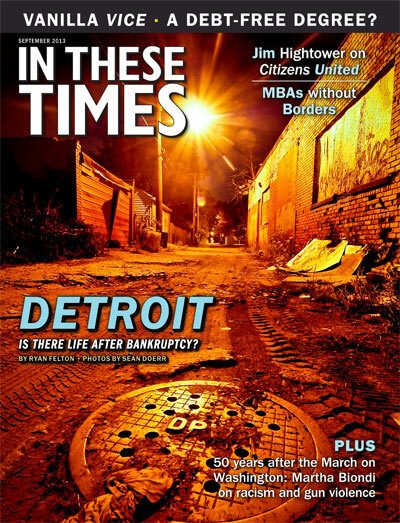MBAs Without Borders
Will a backroom trade deal let the corporate class skip the immigration line?
Cole Stangler

As the House prepares to gut the immigration reform bill that passed the Senate, American trade negotiators are carving out their own deal behind closed doors that could allow multinational conglomerates to move white-collar employees across international borders with ease.
The negotiations are part of the Trans-Pacific Partnership (TPP), a trade deal that, despite covering 40 percent of the global economy, remains so secretive that most members of Congress have never seen the text.
Critics of the TPP, which is shaping up to be the most business-friendly trade agreement in American history, have taken to calling it “NAFTA on steroids.” They charge that the TPP is not about simply boosting trade, but rather enhancing corporate power. The tariffs that exist between the 12 countries involved in the negotiations are already relatively low, and the United States already has free trade agreements with half of them — Chile, Singapore, Canada, Mexico, Peru and Australia.
But in addition to removing barriers to trade, the TPP includes provisions that drastically strengthen intellectual property rights, drawing largely from the extreme copyright protections contained in the failed SOPA and PIPA bills. The deal also bans “Buy America” procurement policies and undermines food safety by easing regulations on imports to the United States. And it expands the scope of already existing investor-state tribunals — international courts charged with resolving cross-border investor disputes — giving them the authority to overrule domestic laws.
The TPP also includes a chapter titled “temporary entry” that could make it easier for certain professionals to move wherever they want within the TPP’s borders. That chapter includes provisions “designed to promote transparency and efficiency in the processing of applications for temporary entry, and ongoing technical cooperation between TPP authorities,” according to a U.S. Trade Representative fact sheet from November 2011. The paragraph-long outline in that fact sheet, which remains the most detailed official public release of the chapter’s content to date, notes that “specific obligations related to individual categories of business person are under discussion.”
While the language is vague, it hints at what has become a key feature of several recent free trade agreements negotiated by the United States: the creation of special visa programs that allow people in certain lucrative professions to bypass the American immigration system that other foreign workers must navigate.
Most workers hoping to enter the United States legally have to obtain one of the highly sought-after visas that are made available each year — and the odds are against them. Some high-skilled workers, such as engineers and IT professionals, can hope to obtain an H1B visa for “specialty occupations,” a topic at the source of much of the debate over comprehensive immigration reform. But if someone who happens to work at, say, a management consulting firm in Mexico City gets a job offer from a different consulting firm in Manhattan, she can apply for a special visa created by NAFTA. That expedited NAFTA visa program, which applies only to Mexico and Canada, allows for a host of other skilled professions also covered by the H1B visa — accountants, engineers, lawyers and scientists among others — to bypass the more time-consuming and demanding H1B process.
The U.S. free trade agreements with Chile and Singapore, which went into effect in 2004, created programs like this for white-collar workers from those nations. Congress also created a similar visa program with Australia shortly after the bilateral free trade agreement between the two nations went into effect in 2005. These three programs are still relatively small, used by approximately 4,000 employees each year. Together, these special programs amount to something like the pre-cleared lines that exist for some corporate travelers at airport security — the elite breeze through, everyone else stands in line.
Since those countries are part of the TPP negotiations, it is likely that some of the other TPP countries will want to negotiate for similar preferential U.S. visa deals, says Lori Wallach, director of Public Citizen’s Global Trade Watch. “New Zealand, Vietnam and Peru [may say], ‘Let me get this straight, those guys get to keep their special quotas, and everyone’s part of the same trade agreement, but somehow we don’t get them? We don’t understand how that can be. That’s not acceptable. So either they have to lose them’ — which, of course, Chile or Singapore would never agree to — ‘or we have to get them.’ ”
As opposed to typical legislation that originates in Congress, anything enshrined in a free trade agreement is very difficult to repeal and requires the consensus of all the treaty’s signatories to modify. This key distinction incentivizes countries to negotiate for visa quota commitments as part of the trade deal, instead of simply lobbying Congress.
But the pressure isn’t only coming from those countries’ negotiators.
For multinationals operating in fields like financial services, telecommunications or building trades, the ability to have a highly skilled and mobile workforce is enormously beneficial — and more profitable. These are, coincidentally, the corporate interests that have had the most sway in crafting the TPP.
About 600 of the roughly 700 advisors that make up the United States Trade Representative’s official trade advisory committees represent business, while about 20 are from organized labor. Some of those corporate interests, like the U.S. Chamber of Commerce and trade advisors from the service industry, have explicitly pushed for new special visa programs to be included in the TPP. It remains to be seen what will emerge in the final trade deal. The full details of the TPP’s temporary entry chapter are only available to the trade negotiators and to the people who sit on the advisory committees and members of Congress on request. As a result, what exactly is being negotiated is not known — despite the fact that the TPP recently ended its 18th round of negotiations and is expected to be finalized by December.
When asked by In These Times if the TPP includes provisions similar to NAFTA for high-skilled professionals, the USTR’s lead negotiator Michael Froman says, “There’s interest in TPP in talking about some of the mobility and persons issues and we’ll be engaging with our trading partners on that, but I don’t know where that stands.”
Publicly, the USTR has made no indication that it is interested in increasing temporary visas. In a statement to In These Times, a spokesperson said that the United States was discussing “temporary entry” only because of the interests of other negotiating parties. The spokesperson said that the TPP chapter only includes measures that help publicize the existing rules on visa commitments and non-visa entry for business people.
The USTR’s response reflects the fact that the issue has become politically sensitive — even more so with the immigration debate currently taking place in Congress. In the past, the USTR has taken heat from Congress for its attempts to unilaterally negotiate American immigration policy. As Wallach points out, “The Constitution is really clear. Congress sets immigration policy — not trade agreements, not the executive branch.”
And as the USTR seeks to shore up as much congressional support as possible ahead of a crucial vote by the end of the summer to allow fast-track authorization of the TPP, the USTR is likely to heed that commitment — at least publicly and in its communication to members of Congress. The USTR wants to avoid jeopardizing “fast-track,” a rule that allows for Congress to only accept or reject TPP, after the agreement is finalized by negotiators.
But because the deal is still hidden from Congress and the public, no one knows for certain what’s actually in there.
“We just want to make sure that what USTR says it’s doing is actually what it’s doing,” says Celeste Drake, trade and globalization policy specialist for the AFL-CIO. Drake points out that new visa programs could be created even if they’re not included in the agreement that passes Congress.
The Australia Free Trade Agreement, for example, did not include specific visa commitments in the actual trade deal. But months later, lobbyists and pressure from the administration convinced Congress to pass a law authorizing a new program.
In a statement to In These Times, the USTR insists that it is focused solely on negotiating this topic through the TPP — not by making any visa agreements after the fact. But the Australia deal may have set an important precedent: If proponents of special visa programs can’t get exactly what they want in trade deals, lobbying Congress hard enough might just do the trick.









